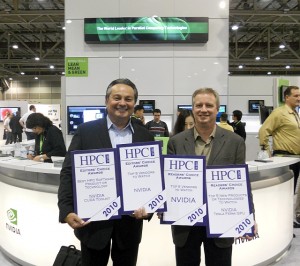nTersect |
| Posted: 01 Dec 2010 01:44 PM PST Last week, NVIDIA's Tesla team enjoyed some high times in the Big Easy during the SC (Supercomputing) 2010 conference in New Orleans. And this year was a landmark one for us. Michael Feldman, Editor in Chief of HPCwire, even stated that "you couldn't miss GPGPU on the show floor" in HPCwire's SC'10 Highlights podcast. For the last 23 years, the Gordon Bell prize has been awarded by the Association for Computing Machinery (ACM) and the Institute of Electrical and Electronics Engineers (IEEE) to recognize outstanding achievements in high performance computing (HPC) applications. This year, two out of the three award winning papers cited their use of NVIDIA GPUs in their research. An 11-strong team led by George Biros, an associate professor at Georgia Tech, consisting of scientists and academics from Oak Ridge National Lab and New York University won a Gordon Bell prize for the world's fastest supercomputing application. The application was a blood-flow simulation of 260 million deformable red blood cells flowing in plasma and when the team compared performance using CPUs-only with a GPU/ CPU configuration on the same problem size, they maintained a 25X speed up. Tsuyoshi Hamada of Nagasaki Advanced Computing Center and Keigo Nitadori of the RIKEN Advanced Science Institute in Japan won the prize in the price/performance category for the second year running. They performed an N-body astrophysics simulation containing 3,278,982,596 particles, on a cluster of 576 GPUs. Using GPUs and CPUs, they achieved sustained performance of 104.8 TFlops, which with an overall hardware cost of $411,921 dollars, led to a price/performance ratio of 254.4 Megaflops to the dollar. Compared to their winning entry from last year (also using NVIDIA GPUs), the simulation was over 2X larger, 4.5X faster and delivered 2.5X better performance per watt using NVIDIA GPUs with the Fermi architecture. Even the best student paper went the way of the GPU. Computer scientists from Tokyo University and Purdue collaborated on their prize winning paper outlining a new programming interface, called OpenMPC, which builds on OpenMP to provide an abstraction of the CUDA programming model, offering high-level control of the parameters and optimizations required to make parallel programming on the GPU even more accessible. What is especially exciting about this work, is that OpenMPC automatically compiles and tunes code, achieving 88% of the performance of the hand-coded CUDA programs. HPCwire also recognized companies in finance, oil and gas and entertainment for their use of GPUs. Citadel Investment Group is getting a 140X improvement in its options pricing models using GPUs and won the Best application of HPC in Financial Services award. Schlumberger won in the Best Application of HPC in Oil and Gas category for their use of GPGPU clusters. At NVIDIA's GPU Technology conference earlier this year, Schlumberger talked about their use of GPUs across a range of finite difference wave propagation methods. Schlumberger is seeing a 6X application level speed up compared to alternative processing solutions and are looking to increase this to 100X in the future. And Weta Digital won the Editors Choice award for Best Application of HPC in Entertainment for their use of GPUs in the movie Avatar. The NVIDIA/Weta Digital jointly developed PantaRay pre-computation engine enables a highly photo-realistic form of rendering called ray tracing to be performed up to 25X faster as compared to CPUs. For the artists in Weta's R&D team, this is a game changer: "Because the complexity continues to scale on each project we do, the amount we need to render continues to multiply. And the more complex the rendering, the harder it is to light the scene. PantaRay makes the complicated scenes as easy to light as the simple scenes." GPGPU was the talk of SC'10, and thanks to the work of our partners, we are now seeing it achieve high honors across many industries. We congratulate them all and look forward to helping them to take their work to the next level in the years to come. |
| You are subscribed to email updates from NVIDIA To stop receiving these emails, you may unsubscribe now. | Email delivery powered by Google |
| Google Inc., 20 West Kinzie, Chicago IL USA 60610 | |






No comments:
Post a Comment